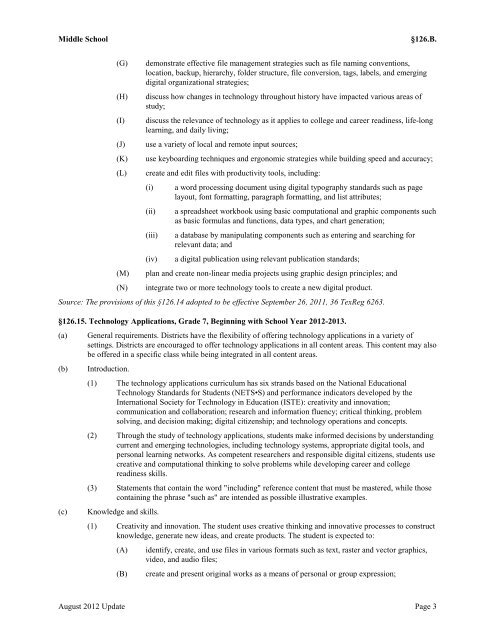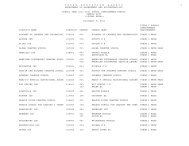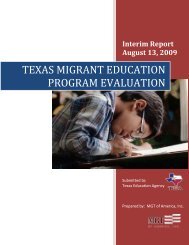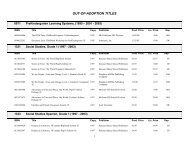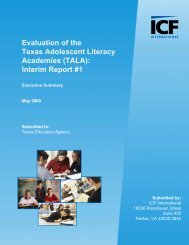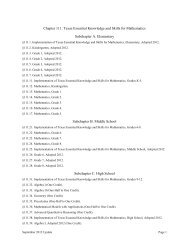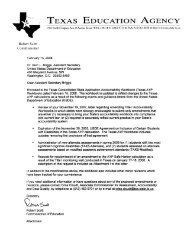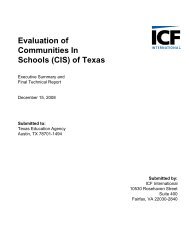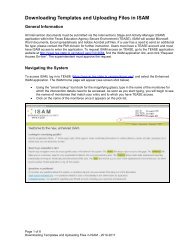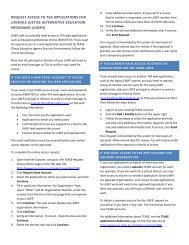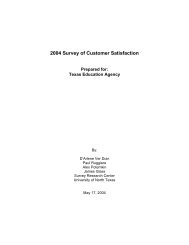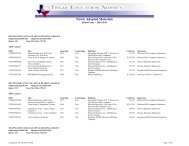Chapter 126. Texas Essential Knowledge and Skills for Technology
Chapter 126. Texas Essential Knowledge and Skills for Technology
Chapter 126. Texas Essential Knowledge and Skills for Technology
You also want an ePaper? Increase the reach of your titles
YUMPU automatically turns print PDFs into web optimized ePapers that Google loves.
Middle School<br />
§<strong>126.</strong>B.<br />
(G)<br />
(H)<br />
(I)<br />
(J)<br />
(K)<br />
(L)<br />
(M)<br />
(N)<br />
demonstrate effective file management strategies such as file naming conventions,<br />
location, backup, hierarchy, folder structure, file conversion, tags, labels, <strong>and</strong> emerging<br />
digital organizational strategies;<br />
discuss how changes in technology throughout history have impacted various areas of<br />
study;<br />
discuss the relevance of technology as it applies to college <strong>and</strong> career readiness, life-long<br />
learning, <strong>and</strong> daily living;<br />
use a variety of local <strong>and</strong> remote input sources;<br />
use keyboarding techniques <strong>and</strong> ergonomic strategies while building speed <strong>and</strong> accuracy;<br />
create <strong>and</strong> edit files with productivity tools, including:<br />
(i)<br />
(ii)<br />
(iii)<br />
(iv)<br />
a word processing document using digital typography st<strong>and</strong>ards such as page<br />
layout, font <strong>for</strong>matting, paragraph <strong>for</strong>matting, <strong>and</strong> list attributes;<br />
a spreadsheet workbook using basic computational <strong>and</strong> graphic components such<br />
as basic <strong>for</strong>mulas <strong>and</strong> functions, data types, <strong>and</strong> chart generation;<br />
a database by manipulating components such as entering <strong>and</strong> searching <strong>for</strong><br />
relevant data; <strong>and</strong><br />
a digital publication using relevant publication st<strong>and</strong>ards;<br />
plan <strong>and</strong> create non-linear media projects using graphic design principles; <strong>and</strong><br />
integrate two or more technology tools to create a new digital product.<br />
Source: The provisions of this §<strong>126.</strong>14 adopted to be effective September 26, 2011, 36 TexReg 6263.<br />
§<strong>126.</strong>15. <strong>Technology</strong> Applications, Grade 7, Beginning with School Year 2012-2013.<br />
(a)<br />
(b)<br />
(c)<br />
General requirements. Districts have the flexibility of offering technology applications in a variety of<br />
settings. Districts are encouraged to offer technology applications in all content areas. This content may also<br />
be offered in a specific class while being integrated in all content areas.<br />
Introduction.<br />
(1) The technology applications curriculum has six str<strong>and</strong>s based on the National Educational<br />
<strong>Technology</strong> St<strong>and</strong>ards <strong>for</strong> Students (NETS•S) <strong>and</strong> per<strong>for</strong>mance indicators developed by the<br />
International Society <strong>for</strong> <strong>Technology</strong> in Education (ISTE): creativity <strong>and</strong> innovation;<br />
communication <strong>and</strong> collaboration; research <strong>and</strong> in<strong>for</strong>mation fluency; critical thinking, problem<br />
solving, <strong>and</strong> decision making; digital citizenship; <strong>and</strong> technology operations <strong>and</strong> concepts.<br />
(2) Through the study of technology applications, students make in<strong>for</strong>med decisions by underst<strong>and</strong>ing<br />
current <strong>and</strong> emerging technologies, including technology systems, appropriate digital tools, <strong>and</strong><br />
personal learning networks. As competent researchers <strong>and</strong> responsible digital citizens, students use<br />
creative <strong>and</strong> computational thinking to solve problems while developing career <strong>and</strong> college<br />
readiness skills.<br />
(3) Statements that contain the word "including" reference content that must be mastered, while those<br />
containing the phrase "such as" are intended as possible illustrative examples.<br />
<strong>Knowledge</strong> <strong>and</strong> skills.<br />
(1) Creativity <strong>and</strong> innovation. The student uses creative thinking <strong>and</strong> innovative processes to construct<br />
knowledge, generate new ideas, <strong>and</strong> create products. The student is expected to:<br />
(A)<br />
(B)<br />
identify, create, <strong>and</strong> use files in various <strong>for</strong>mats such as text, raster <strong>and</strong> vector graphics,<br />
video, <strong>and</strong> audio files;<br />
create <strong>and</strong> present original works as a means of personal or group expression;<br />
August 2012 Update Page 3


